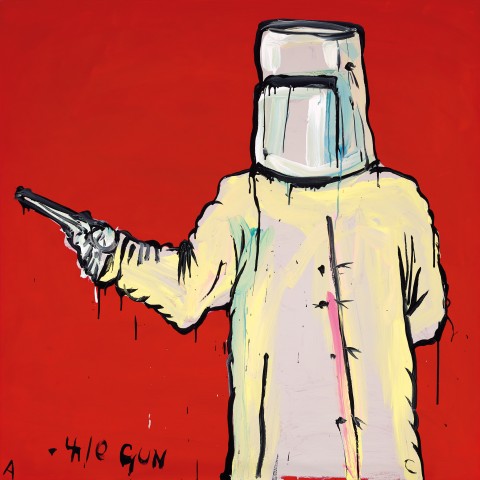.410 GUN, c.2009
ADAM CULLEN
synthetic polymer paint on canvas
153.0 x 153.0 cm
signed and inscribed with title lower left: A / . 410 GUN / C
Chalk Horse Gallery, Sydney
Art Equity, Sydney
Private collection, New South Wales, acquired from the above in 2010
With a bold composition and lustrous paint, enfant terrible Adam Cullen’s Ned Kelly is divorced from the landscape which had moulded him into an iconic bush hero. Adam Cullen’s paintings often feature individual figures painted with a folkish primitivism and placed against a saturated, monochrome background. They are thus transformed into symbolic anonymous figures of vernacular Australian culture and of Cullen’s personal pantheon: the outlaw, the gangster, the boxer, the policeman, the cowboy and the cocktail girl.
Beneath the artist’s often puerile humour lies a rich seam of social commentary and nationalistic fervour. Following in the footsteps of artist Sir Sidney Nolan, contemporary painter Adam Cullen found in the folk outlaw Ned Kelly both an Irish kinship and a relatable outcast figure who mirrored his own sense of wild lawlessness. With Cullen’s punk-inspired spirit of transgression and a pervasive interest in violence, the figure of Ned Kelly was an obvious and enduring icon for the artist – appearing in many of his paintings from mid 2000s onwards, either alone or alongside his dogged policemen. The simple portrait composition of Kelly, looming large and toting a sawn-off shotgun reinforces the symbolic nature of his person in Australian culture – untethered to time and place and reimagined by successive generations.
In 1999, critic Bruce James described Adam Cullen’s style as ‘a creole of perceptions, correct in themselves but incorrectly articulated’, with a ‘material coarseness calculated to offend the sensibilities of anyone who favours surface effects over subliminal content’.1 Painted some ten years later, .410 Gun entices with surface effects of dripping liquid outlines and bright colours, providing a formal entry point into an intimidating portrait of an impenetrable masked figure brandishing a weapon.
Weapons played a vital role in the shaping of the Kelly legend, with their proficiency in marksmanship becoming a strong element for artistic interpretation. The artist has annotated the title of this painting directly on to the front of the canvas, naming it with the caliber measure of the shotgun with which Kelly defended Glenrowan. Words in Cullen’s practice can be read as text, informing the viewer of the artist’s intent, but are also incorporated into the painting as part of the image – slanted and misspelt, complementing the paintings’ raw immediacy. For all of its superficial bravura, there is an underling poignancy to Cullen using the faceless icon of a 19th century bushranger to comment on what Tunnicliffe identifies in his artwork as ‘a gap between how we see ourselves and what we are, even when we appear our most heroic.’2
1. James, B., ‘Finding diamonds in the rough’, Sydney Morning Herald, Sydney, 13 July 1999, p. 12
2. Tunnicliffe, W., Adam Cullen. Let’s Get Lost, Art Gallery of New South Wales, Sydney, 2008, p. 16
LUCIE REEVES-SMITH
